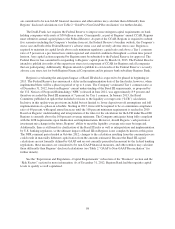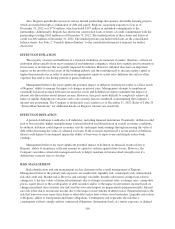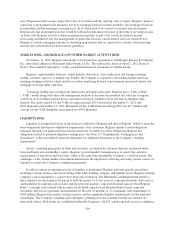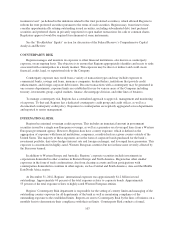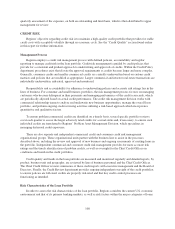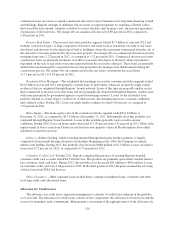Regions Bank 2012 Annual Report Download - page 118
Download and view the complete annual report
Please find page 118 of the 2012 Regions Bank annual report below. You can navigate through the pages in the report by either clicking on the pages listed below, or by using the keyword search tool below to find specific information within the annual report.
Exposure to Interest Rate Movements—As of December 31, 2012, Regions was moderately asset sensitive
to both gradual and instantaneous rate shifts as compared to the base case for the measurement horizon ending
December 2013. Table 29 “Interest Rate Sensitivity” illustrates several rate shift scenarios. The protractedly low
interest-rate environment that has prevailed over the past few years has led many borrowers, especially those
with loans at fixed rates of interest, to refinance or prepay their loans. This has resulted in considerable pressure
on net interest margin and net interest income as these loans and fixed rate investment securities were replaced
by other assets at lower yields. However, at the same time, the broader economic conditions and the level of
short-term interest-rates, in particular, produced ample opportunities for the reduction of deposit and borrowing
costs. If long-term rates were to decline materially from the recent implied market-forward outlook, Regions’
loan and securities portfolios would expect to be subject to higher levels of prepayment. Deposit costs, having
benefited from several years of very low short-term rates, would likely experience additional reduction from
recent levels, but the magnitude of decline may not be as pronounced as in the past few years. In total, Regions
estimates an impact of a 50 basis points instantaneous and gradual decline in interest rates at ($135) million and
($112) million respectively, for the measurement period ending December 2013. (Note that where scenarios
would indicate negative interest rates, a minimum of zero is applied). In the converse environment, in which rates
rise, Regions estimates that the speed of loan and securities prepayment will slow considerably and deposit rates
would rise, but the negative impact of these factors would be more than offset by higher rates on new loans and
securities as well as the repricing of existing floating rate loans.
Table 29—Interest Rate Sensitivity
Gradual Change in Interest Rates
Estimated Annual Change in Net Interest Income
December 31, 2012
(In millions)
+200 basis points ............................ $402
+100 basis points ............................ 216
-50 basis points ............................. (112)
Instantaneous Change in Interest Rates
+200 basis points ............................ $484
+100 basis points ............................ 262
-50 basis points ............................. (135)
Interest rate movements may also have an impact on the value of Regions’ securities portfolio, which can
directly impact the carrying value of shareholders’ equity. Regions from time to time may hedge these price
movements with derivatives (as discussed below).
Derivatives— Regions uses financial derivative instruments for management of interest rate sensitivity. The
Asset and Liability Committee (“ALCO”), which consists of members of Regions’ senior management team, in
its oversight role for the management of interest rate sensitivity, approves the use of derivatives in balance sheet
hedging strategies. The most common derivatives Regions employs are forward rate contracts, Eurodollar futures
contracts, interest rate swaps, options on interest rate swaps, interest rate caps and floors, and forward sale
commitments. Derivatives are also used to offset the risks associated with customer derivatives, which include
interest rate, credit and foreign exchange risks.
Forward rate contracts are commitments to buy or sell financial instruments at a future date at a specified
price or yield. A Eurodollar futures contract is a future on a Eurodollar deposit. Eurodollar futures contracts
subject Regions to market risk associated with changes in interest rates. Because futures contracts are cash settled
daily, there is minimal credit risk associated with Eurodollar futures. Interest rate swaps are contractual
agreements typically entered into to exchange fixed for variable (or vice versa) streams of interest payments. The
notional principal is not exchanged but is used as a reference for the size of interest settlements. Interest rate
102








